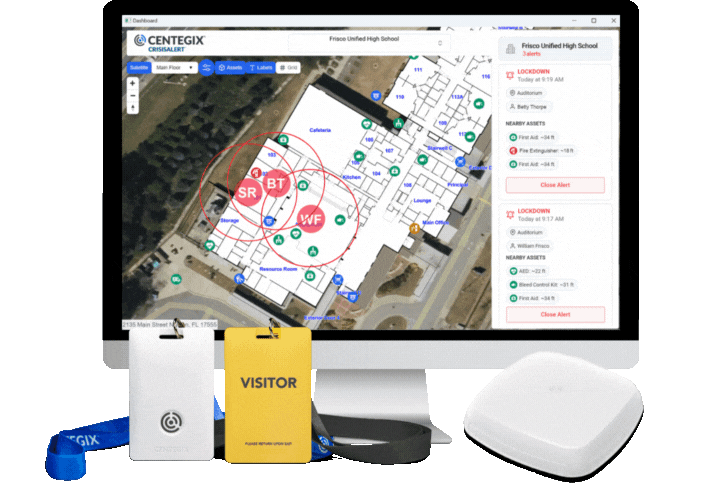Your school safety and security helps keep teachers and prevents teacher burnout.
“There’s a correlation between safety, retention, recruitment, and wellness. No one is coming to your district if it’s considered dangerous.” – Chief Thomas Trawick
On June 23rd, CENTEGIX hosted a webinar: School Safety And Teacher Retention with Mr. Jay Floyd, superintendent of Hart County Charter System in Georgia, and Chief Thomas Trawick, School Resource Officer of Clayton County Public Schools in Georgia.
Both Floyd and Trawick share a very specific point of view to the webinar, and their insights are invaluable to district leaders in their school safety/prevention plans as well as teacher retention.
Floyd believes that when it comes to school safety: “If you expect it, then you inspect it.” He believes that CENTEGIX brings a lot of pieces of school culture together, like teacher retention and recruitment. He sees CENTEGIX as a real solution for the teachers, giving them a lot of power in their hands.
Adding to that, Chief Trawick noted, “There’s a correlation between safety, retention, recruitment, and wellness. No one is coming to your district if it’s considered dangerous.”
The webinar detailed the captured data from CrisisAlert usage and how to make the most informed decisions when it comes to school safety, prevention, and teacher wellness.
This blog post covers the captured data and how it can be used and applied to school improvement and response for additional support. The webinar also included thoughts from teachers around the country who partner with CENTEGIX.
Addressing the day-to-day challenges of classroom teaching
While violence against schools is an important topic in the news media, politics, and social media platforms, it’s not the most prevalent issue for teachers in their day-to-day responsibilities.
Based upon the captured data from CrisisAlert, it’s not just the extreme incidents that happen in our country. It’s the day-to-day things that impact teachers and students the most.
More specifically, medical emergencies.
Swift Medical and Emergency Responses With CrisisAlert
Teachers feel relieved to know they have the support of safety and security while in their classrooms.
Teachers aren’t just teachers. They’re more than that.
They’re nurses, counselors, and advocates. So, when a medical emergency, like an allergic reaction or a seizure, happens, they’re the only one who can get help in that critical moment. With CrisisAlert, teachers know they have the ability to ascertain an immediate response to the classroom with emergency services knowing exactly where to go.
CrisisAlert provides that tool that informs the entire school while identifying where the incident is occurring. As a result, medical assistance gets to the classroom rapidly to mitigate the situation.
Teachers feel prepared at a moment’s notice with a tool they can rely on and employ when they need it most.
De-Escalation, Prevention, and Response to Behaviors
But medical emergencies aren’t the only issues that happen in the classroom. There’s also behavioral issues that escalate into emergencies.
Student behavior is the biggest trigger of alerts. These types of alerts are leveraged much more than any other type of alert. This is due, in large part, to the pandemic. Students feel more isolated and less connected than ever before. They returned to in-person learning not just with academic gaps, but with gaps in their mental health and wellness and social-emotional learning.
Based on the captured data, schools are seeing an uptick in the numbers of behavioral responses from the 2021-2022 school year.
Floyd confirmed the uptick in his own district. There’s been more fights and disagreements on the rise.
You can’t have teaching and learning if you have an environment that’s chaotic and unsafe.
With the number of alerts Floyd’s received, teachers are appreciative in having the ability to notify administration. They have options to trigger the type of response they need, whether it’s admin help or emergency services.
Chief Trawick confirmed the data as well, “We’ve had a significant increase in our medical and mental health challenges in our classrooms.”
But the SRO helps to stabilize and assist the administration and counselors while also helping with getting the students the support they need.
Actionable and Effective School Improvement Plans
While the data points to an increase in student behavior, districts can use this data to inform a school improvement plan.
School campuses are large in terms of square footage. This includes those nooks and crannies where there’s limited camera visibility and exterior areas of recreation like soccer and football fields.
Districts usually only have one or two school resource officers. So, they can only be in one place at one time. Fights get started from conversations or disagreements that lead to provocations.
Once the situation escalates, teachers see its initiation of the problem. So they can easily use their CrisisAlert badge to call for help. This mitigates and de-escalates the situation. School personnel, like guidance counselors, can use conflict resolution or peer mitigation to help students self-regulate.
This is a valuable tool, and it shows a decrease in the numbers as it relates to fights in school. Chief Trawick’s seen a decrease in suspension rates because SROs are able to get to incidents quickly and mitigate the situation.
When there’s less suspensions and more conflict resolutions applied, the overall school culture improves.
Parent and Community Support
Floyd mentions that while the mental health challenges increased, the surprising piece is the support of the parents. They understand that the district is getting the child in crisis the resources he or she needs.
Not only that, with spotty cell service in most buildings, no one has to rely on their cell phone for help, which parents and teachers really appreciate. CrisisAlert still operates without service. This feature helps tremendously and gives a sense of satisfaction to teachers and the community because they know the device works regardless.
Another improvement to Floyd’s safety plan–he noted that the district isn’t near a local hospital. He’s received countless letters from parents thanking the school board and administration for having something in place for students with medical needs like seizures or mental health emergencies.
A parent of a child who experienced an emergency even mentioned in their letter that they weren’t so sure what would have happened if the response was not as quick as it was, and how grateful they are for that.
The community supports Floyd’s use of CrisisAlert and CENTEGIX because they understand how it works and that the element of time is now on the school’s side.
Common Sense School Safety Plans
With swift and accurate emergency and administrative responses, teachers, parents, and students feel safer in schools. This, in turn, creates a school culture where every person feels valued enough to be kept safe.
Watch more of the webinar and learn how else CENTEGIX and CrisisAlert has positively impacted schools.
Ready to learn how CrisisAlert can help your school specifically? Book a free demo here.









